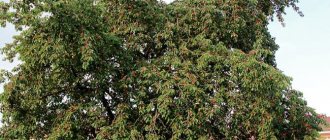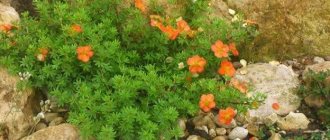Sloes bear fruit well in a variety of regions. It grows in both steppe and wooded areas, especially in the presence of reservoirs. Sloes can also be grown on your own plot.
The fruits of the bush are small in size, dark in color, and have a sour taste. Berries contain many vitamins and amino acids.
Thorn in the country - plant or get rid of
Adding an article to a new collection
There are many plants that some summer residents dream of, but cannot have on their property, while others struggle with them and cannot drive them away from their territory.
Such controversial crops include thorns. Thorn, or blackthorn, or prickly plum - all these are names of the same plant. It can be either a shrub or a small tree. The thorn bush usually does not exceed 4.5 m; the tree can reach 8 m in height. The main distinguishing feature of the culture is the presence of a large number of thorns. It was the thorns that gave the bush its name: in the Proto-Slavic language, “thorn” is “thorn.”
Sloe photo
Read here - Properties of blueberries: contraindications for use and features of use for the body (115 photos and videos)
Thorn on the site: pros and cons
Thorn is a very controversial plant. There are summer residents who would never agree to have this thorny bush on their property. There are several reasons for such dislike:
- Thorns. Sharp thorn needles can cause injury. This is especially true in families with small children.
- Fruit. Both their size and taste are not very attractive to summer residents. Small - only 12 mm - drupes have a sour taste. Another drawback is their strong astringency.
- Collection. Harvesting is not easy. Dense bushes and branches covered with thorns make this work extremely difficult.
However, we must give the blackthorn its due: it also has many advantages.
- Unpretentiousness. Sloes can grow anywhere and in any conditions. He is not afraid of frost, drought, or infertile soils.
- Harvest. The absolute unpretentiousness of the bush allows you to get a large harvest every year, regardless of weather conditions.
- Hedge. Sloe bushes can be used to make hedges because they tolerate pruning easily and recover quickly from it.
- Protection. Thanks to its thorns, the blackthorn becomes an excellent protector and protects the area from uninvited guests.
How to care for thorns
More than a century ago, the famous breeder Ivan Michurin developed several varieties of a hybrid of plums and sloe - damsons. However, for some reason he called them thorns: dessert thorn and sweet thorn. Later, Thorn large-fruited and Thorn superabundant also appeared. Unlike traditional thorns, these trees do not have the main disadvantages of shrubs: hybrids have almost no thorns, and the fruits are sweet and not so tart. Nowadays you can find both sloe and damson trees in summer cottages.
Both cultures are equally unpretentious to growing conditions. They are able to withstand both extreme heat and frost down to -40°C. They can grow even in alkaline soils. They feel equally good in sunny areas and in the shade.
The sloe will bear fruit well even on poor soils. However, if you feed it once every few years with complex mineral fertilizer, the harvest will be more abundant. In addition, thorns that are not used for hedges or cut need sanitary pruning from time to time.
How to plant sloe in the garden
Sloes and damsons can be propagated in several ways:
- Bones. They are removed from the pulp of a ripened fruit in the fall, freed from the pulp and planted in open ground. The planting depth is small - only 6-7 cm. The planting site must be covered. When shoots appear, remove the protective layer and leave the seedlings to grow. After 2 years they can be planted in a permanent place.
- Cuttings. Propagation by cuttings should be carried out in the spring. Cut the cuttings, each of which should have at least 5-6 buds. For rooting, place them in small greenhouses (or cover with a transparent jar or bottle on top). During the summer, maintain a constant level of humidity inside the shelter. By autumn, cuttings with a developed root system can be planted in a permanent place in open ground.
- Root shoots. In the spring, carefully separate the shoot from the mother plant and plant it immediately in a permanent place. Care consists of regular watering and feeding with a nutrient solution.
When planting seedlings in a permanent place, pay attention to the size of the planting hole. It depends on the root system of the plant, but must be at least 60 cm in diameter. The distance between seedlings is determined by the size of the thorn or damson: at least 1 m for bushes and about 3-4 m for trees.
The thorn grows very quickly. If you don’t want to end up in thorn bushes one day, take care of this at the planting stage. Dig a limiter around the perimeter of the planting hole that will control the growth of roots. Sheets of slate or roofing felt can be used as a limiter.
Related article: Radish vegetable: planting and care in open ground, photo, growing from seeds, harvesting and storage
Botanical description
Blackthorn, blackthorn or prickly plum - there are so many names that the shrub belonging to the Rosaceae family, the Plum genus, has. The distribution area is extensive. It grows in the Taiga, Asia Minor, Western Siberia, the Caucasus, the European part of Russia, Western Europe, and the Mediterranean. Loves temperate climates. In nature you can find both wild and cultivated thorns. Without human control, it creates dense thickets on the edges of forests, cutting areas, and steppes.
Sloe plum grows in the form of shrubs or small trees 1.5-3 meters high. Adult, large individuals reach 4-8 meters. The branches of the bushes are equipped with numerous thorns. A sharp, thick thorn also crowns the end of adult branches, which are located horizontally to the ground. Young branches are drooping. Young leaves are also distinguished by this property. With age, the leaves change color, becoming leathery and dark green. But the shape is the same throughout the life cycle of the blackthorn - elliptical or obovate.
You can enjoy the fruits when the fruit tree reaches 2-3 years of age. Thorn berries are quite small, only 1-1.5 cm in diameter. Characteristic is a waxy coating covering the black-blue surface of the berries. The pulp, regardless of the degree of ripeness, is green. The berry has one seed, which is difficult to separate from the pulp. The harvest can be harvested in late summer, early autumn. Unpicked berries tenaciously hold on to the stalk and can hang on the tree until next spring.
The taste of blackthorn is tart, sometimes sour. Connoisseurs of softer shades wait for the first frosts, which smooth out the astringency of the berries.
Useful properties of thorns
The fruits of thorns and damsons appear only in late August - early September. Their size depends on the variety. Due to their astringency, sloe fruits, unlike damsons, are almost never used as fresh food. Otherwise, their application is not much different from each other. They make jam, wine and kvass. Some housewives add the fruits of these plants to first and second courses. Thanks to the acid they contain, they add sourness to food.
Not only the fruits of the thorn are useful, but also its leaves. The amount of vitamin C in them is greater than in currants. For this reason, they make healthy vitamin tea.
Useful substances in the composition of thorn fruits
The health benefits of thorns are due to the presence of the following substances in the fruit:
- vitamins A, B, C, EE and PP;
- essential oils;
- cellulose;
- tannins;
- pectin;
- alimentary fiber.
The fruits also contain quite a lot of calcium, copper, magnesium, phosphorus, sodium and cobalt. They have a relatively low calorie content; 100 g of product contains about 50-55 kcal.
When consuming the product, you need to consider both the benefits and harms of thorns. In some cases, these fruits should be discarded. For example, if you have diabetes, you should first consult a doctor.
The glycemic index of the product is 30 units, which is generally acceptable for diabetics. However, it should not be used in excessive quantities, especially without consultation.
How to remove thorns from the site
If you are determined to remove the thorn from the site, then you will have to work hard. Sometimes it can take several years to fight it. To quickly solve the problem, the war against thorn bushes must be started on all fronts, in a comprehensive manner.
- Dig all the bushes as deep as you can. Bare the remaining roots.
- Sprinkle a thick layer of salt over the roots and the soil around them.
- Water the tree trunk circles with any herbicides that can help in the fight against shrubs. Roundup, Tornado, etc. are suitable.
- Cover as much of the area as possible with black film. It will deprive the roots of access to light - the main factor in the development of all plants.
- When new shoots appear, destroy them immediately and do not allow them to grow and develop.
We tried to introduce you to the positive and negative sides of the turn. Whether you leave this unpretentious shrub on your site or get rid of it completely is up to you.
Thorn bush: planting and care, photo, pruning, propagation, properties - harm and benefit
Blackthorn, or blackthorn for short (Prunus spinosa), is a low shrub with thorns on its stems that belongs to the genus Prunus. For this reason, it is called prickly plum. The origin of the name is associated with the ancient Slavic language; in translation, thorn means “thorn”. Blackthorn grows in temperate latitudes, preferably on forest edges or in steppes, forming continuous and impenetrable stands. In the Crimea and the Caucasus, thorns are found high in the mountains. Under natural conditions, prickly plum thickets are common in Western Europe, northern Africa, Siberia and Asia Minor.
People learned about the thorn tree during the reign of Ancient Greece and Rome. In Christian teaching, thorns symbolize the suffering of God's son, Jesus. Even on the pages of Holy Scripture there is a mention of the thorn bush.
Botanical description
Blackthorn, blackthorn or prickly plum - there are so many names that the shrub belonging to the Rosaceae family, the Plum genus, has. The distribution area is extensive. It grows in the Taiga, Asia Minor, Western Siberia, the Caucasus, the European part of Russia, Western Europe, and the Mediterranean. Loves temperate climates. In nature you can find both wild and cultivated thorns. Without human control, it creates dense thickets on the edges of forests, cutting areas, and steppes.
Sloe plum grows in the form of shrubs or small trees 1.5-3 meters high. Adult, large individuals reach 4-8 meters. The branches of the bushes are equipped with numerous thorns. A sharp, thick thorn also crowns the end of adult branches, which are located horizontally to the ground. Young branches are drooping. Young leaves are also distinguished by this property. With age, the leaves change color, becoming leathery and dark green. But the shape is the same throughout the life cycle of the blackthorn - elliptical or obovate.
You can enjoy the fruits when the fruit tree reaches 2-3 years of age. Thorn berries are quite small, only 1-1.5 cm in diameter. Characteristic is a waxy coating covering the black-blue surface of the berries. The pulp, regardless of the degree of ripeness, is green. The berry has one seed, which is difficult to separate from the pulp. The harvest can be harvested in late summer, early autumn. Unpicked berries tenaciously hold on to the stalk and can hang on the tree until next spring.
The taste of blackthorn is tart, sometimes sour. Connoisseurs of softer shades wait for the first frosts, which smooth out the astringency of the berries.
Description of the thorn bush
The thorn bush is capable of reaching a height of 3.5 to 4.5 m. Thorn trees grow up to 8 m. Dense basal shoots create a wide, branched and prickly crown, making the plant quite difficult to approach. The main root is buried almost a meter into the ground, and the rhizome can extend beyond the circumference of the crown. The stems of thorns are covered with thorns. The length of the leaves is no more than 5 cm. The shape of the leaf blades is ellipsoidal, the edges are serrated. The snow-white flowers are arranged singly. Flowering begins in the spring before the first leaves appear. In place of the flowers, purple fruits are formed, covered with wax and resembling a plum. The taste of damson berries is tart and sour. Their diameter does not exceed 12 mm.
The shrub bears fruit only when it reaches two or three years of age. Sloes demonstrate resistance to drought and are considered an excellent honey plant. Even an inexperienced gardener can plant a plant and then care for it. In gardens, blackthorn is planted as a hedge. As they grow, the branches of the bush reliably protect the slopes from landslides. For decorative purposes, the following varieties of thorns are used: purple, red-leaved and terry.
Description
Jujube (unabi) is a plant of the buckthorn family. There are other names for these fruits: unabi, jujube, and also Chinese date. The berries are found in large quantities throughout Asia, Europe, Japan and Australia. Most often, the plant can be found in areas with sunny slopes of mountains and hills.
Fleshy fruits can be round or ovoid. During the ripening period, the smooth peel acquires a brown color with a red tint (see photo). Inside there is a sweet-tasting and quite juicy pulp.
Planting thorns in open ground
Best time to plant sloe
The optimal time for planting sloe in open ground is early spring. However, the preparation of the planting hole is carried out in the fall. Thanks to this, the soil will settle well and compact. Sloes survive in saline and infertile soils and withstand spring floods. At the same time, heavy and waterlogged substrates often cause frostbite in the root system.
The most suitable area for planting sloe is an open space in the garden with nutritious neutral soil.
How to plant a thorn correctly
The walls of the dug hole are covered with slate or pieces of old iron, which will protect neighboring plants from growing damson branches. Before lowering the seedling into the hole, the bottom is sprinkled with crushed eggshells, which were collected over the winter. Then fill the hole with soil consisting of humus, superphosphate and potassium fertilizer. Soil with an acidic environment is diluted with lime. Seedlings are placed at intervals of 2-3 m from each other.
For planting material, choose strong and healthy bushes. The roots are pre-treated with a sodium solution. A stake is placed at the bottom of the hole, soil is evenly distributed around it and a seedling is placed in the center. The roots are leveled and covered with a fertilized substrate mixture so that the root collar protrudes above the surface by at least 3 cm. The boundaries of the tree trunk circle are marked with a kind of edge. This method allows you to retain moisture and prevent water from spreading during watering. Each bush requires about 2-3 buckets of water. After moisture is absorbed, the area where the sloe will be grown is mulched with humus, which prevents the moisture from quickly evaporating. The seedling is tied to a peg.
It is better to trim thorn branches after planting thorns. The next year, with the arrival of spring, they do sanitary and formative pruning of the bushes.
Landing
Sloes are planted in the ground in the spring, when the ground has warmed up. But it is better to start preparing the hole in the fall, so that it can settle properly over the course of several winter months. Sloes grow best on dry, clay or sandy substrates. The culture is not afraid of intense snow melting in early spring. At the same time, it is not worth planting it in soil that is too moist, since in such an area in winter there is a high risk of roots freezing. The optimal solution for planting blackthorn will be well-lit places with a substrate rich in nutrients. Acidity should be moderate.
For planting, forms a hole about 70 cm deep and about 1 m wide. To prevent the intensive growth of thorns, it is advisable to cover the steep edges of the hole with unnecessary slate or sheets of any metal. A week before planting, you need to pour crushed shells into the hole. It can be collected throughout the winter. The shell layer is sprinkled with a substrate made up of garden soil with the addition of 1.5-2 buckets of compost. Additionally, 70 g of potassium preparation and 400 g of superphosphate are poured into such soil. In highly acidic soil, add a little lime. If wild plum is planted to form a hedge, then a distance of 1.5-2 m must be maintained between individual plants.
Seedlings aged 2 years are suitable for planting. Before placing them in open ground, their roots should be kept in a solution of “Kornevin” or sodium humate. In the very middle of the pit you need to fix the support column. The seedling is placed evenly in the hole. Then the roots are carefully straightened, after which they are sprinkled with soil mixture so that the root collar rises 3-4 cm above the ground level. The earth is slightly compacted and the near-trunk area is protected with an earthen border 10-15 cm high. Immediately after planting, the young plant is watered at the rate of 20-15 cm. 30 liters for each seedling.
Caring for thorns in the garden
Caring for thorn shrubs is quite simple and even a novice gardener can do it. It is important to follow several rules: regularly water, feed the plant, loosen the soil, remove weeds, trim branches that are too thick, and cover the bushes for the winter.
Article on the topic: Vriesia flower: care at home, photo, transplantation, propagation, what after flowering
Watering
Immediately after planting the sloe, the young bush will only need one watering per week, then watering is reduced. Only when the blackthorn begins to actively grow, the moisture supply is resumed. During the year, the shrub has enough natural rainfall, but if a prolonged drought occurs, two buckets of settled water are poured under the seedlings.
Feeding
For normal and abundant fruiting, it is necessary to feed the sloe with organic or mineral fertilizers once a season. Bushes that grow in the same place for a long time need to be fed first.
Trimming
Thorn pruning activities are carried out in the spring, before sap flow begins. Dried and deformed branches are removed. Blackthorn has a tendency to thicken, as a result of which the crown should be thinned out regularly. You can leave only five strong fruiting branches. The cup-shaped bush shape is most common for garden growing of sloe.
In autumn, pruning of plants is performed exclusively for sanitary purposes, in order to get rid of old and broken branches. This is done after the foliage has fallen and the thorn bushes are preparing for winter.
Sloe propagation methods
Sloes are propagated using seeds, cuttings or root suckers. The seed method is time-consuming. As practice shows, vegetative propagation is much more successful.
Propagation by seeds
In September, the fruit seed is separated from the pulp and placed in the soil. Planting is done in the spring after seed stratification. To make them germinate faster, the seeds are soaked in honey syrup for several hours. After this, they are planted in nutrient soil, deepening 6 cm into the ground. The plantings are covered with film to create a greenhouse effect. When a couple of healthy leaves appear, the cover is removed. After two years, the seedlings are ready to be transplanted to a new location.
Propagation by cuttings
For cuttings, select cuttings that have 5 healthy buds. With the arrival of spring, they are placed in a container filled with fertile substrate, lightly covered and transferred to the greenhouse, trying to ensure constant watering and fertilizing. After 3-4 months, the cuttings take root.
Reproduction by offspring
The root shoots are carefully separated from the main bush, after which they are planted in shallow holes. It is better to maintain an interval of at least a meter between individual copies.
Landing
Sloes are planted in the ground in the spring, when the ground has warmed up. But it is better to start preparing the hole in the fall, so that it can settle properly over the course of several winter months. Sloes grow best on dry, clay or sandy substrates. The culture is not afraid of intense snow melting in early spring. At the same time, it is not worth planting it in soil that is too moist, since in such an area in winter there is a high risk of roots freezing. The optimal solution for planting blackthorn will be well-lit places with a substrate rich in nutrients. Acidity should be moderate.
For planting, forms a hole about 70 cm deep and about 1 m wide. To prevent the intensive growth of thorns, it is advisable to cover the steep edges of the hole with unnecessary slate or sheets of any metal. A week before planting, you need to pour crushed shells into the hole. It can be collected throughout the winter. The shell layer is sprinkled with a substrate made up of garden soil with the addition of 1.5-2 buckets of compost. Additionally, 70 g of potassium preparation and 400 g of superphosphate are poured into such soil. In highly acidic soil, add a little lime. If wild plum is planted to form a hedge, then a distance of 1.5-2 m must be maintained between individual plants.
Diseases and pests of thorns
Thorn shows resistance to various diseases and pests. Cases of moniliosis are rarely observed. The cause of this fungal disease is monilia spores, which penetrate the calyx of the flower and infect young branches. Signs of the disease are darkening of leaf blades and shoots. Over time, the plant dies completely, the foliage turns yellow and falls off. Fruiting is noticeably reduced, the surface of the drupes begins to crack, and the fruits rot. Treatment of shrubs with fungicidal preparations helps to cope with moniliosis fungus. It is recommended to use Horus solution. It is capable of destroying fungus even in the cold season. Other effective drugs in the fight against gray mold are Gamair, Rovral, Bordeaux mixture and copper sulfate. The preparation of solutions must be carried out strictly according to the instructions.
Dangerous pests also include aphids - insectivores that feed on plant sap and eat leaves, causing the leaves to curl and turn yellow. Aphids multiply quickly and seriously damage shrubs, transmitting viral infections to neighboring plantings. To destroy aphids, acaricidal solutions of Aktara or Antitlin are used. To consolidate the effect, the treatment is repeated.
Properties of thorns: benefits and harms
Useful properties of thorns
Sloe fruits contain a large amount of healthy sugars, acids, pectin and tannins, fiber, vitamin C, E, and mineral salts. Fresh or processed blackthorn berries can have an astringent effect. They are used in the treatment of diseases of the gastrointestinal tract, ulcers, dysentery, poisoning, and vitamin deficiency.
Wine made from thorn fruits is considered medicinal. It is recommended to add it to the diet for infectious diseases, kidney and liver pathologies, symptoms of neuralgia and metabolic disorders in the body. Eating blackthorn berries helps lower body temperature and is used as a diaphoretic.
Experts advise using the fruits and flowers of thorns if patients suffer from edema, cystitis or urolithiasis.
Blackthorn flowers contain unique components that have a mild laxative effect, heal wounds and skin rashes, and normalize the functioning of the kidneys and intestines. Decoctions and infusions of thorn flowers act as a diuretic and diaphoretic. Doctors prescribe decoctions for hypertension, shortness of breath and constipation.
Berry juice has antibacterial properties, which increases the body's resistance to various parasites. Taking decoctions of thorns relieves inflammation of the mucous membrane. Tea made from the leaves is a good laxative for constipation. Substances contained in plant tissues relax the muscles of internal organs and reduce vascular permeability.
Contraindications
Despite all its beneficial properties, blackthorn is contraindicated for people with gastritis and stomach ulcers. Sloe seeds are poisonous, and the berries can cause an allergic reaction in rare cases.
Benefits for pregnant and lactating women
The benefit of sloe berries for pregnant women is to reduce the symptoms of toxicosis. However, you should not consume the product in large quantities.
Some people are allergic to components of sloe fruit. This can lead to serious problems during pregnancy.
Therefore, it is advisable to first consult and undergo an allergy test. If there are signs of an allergic reaction, you should stop eating thorns.
Thorn bush: planting and care, photo, pruning, propagation, properties - harm and benefit
This plant is popularly called differently: damson, blackthorn and even damson. In fact, most often it means an ordinary thorn - the one that is famous primarily for its thorns and ability to create completely insurmountable thickets.
poor, clayey, neutral, sandy, fertile, slightly acidic, medium fertility, loamy, sandy loam, alkaline
partial shade, direct sunlight, diffuse sunlight
What is a thorn? Sloe, otherwise known as Prickly Plum, is a dense, rapidly growing and very prickly shrub, extremely winter-hardy, drought-resistant and unpretentious. It blooms in April-May, even before the leaves bloom, and looks quite impressive at this time. The fruits ripen in July-August and remain on the branches until winter. Freezing is very beneficial for them: the astringency is lost and the taste significantly improves. Productivity is approximately 12-15 kg per bush. Harvesting the fruit is difficult due to the large number of sharp thorns.
Article on the topic: Fieldfare: planting and care in open ground, photos, types and varieties
Thorn is not particularly widespread as a fruit crop, and in vain: despite the peculiar taste, its fruits are truly medicinal. They are rich in vitamins (primarily ascorbic acid and vitamin P), their juice has antibacterial properties and is used to treat diseases of the skin, gastrointestinal tract and kidneys. Sloe berry compote is an excellent homemade preparation for the winter; it is tasty and perfectly supports the immune system. And homemade sloe wine is one of those undeservedly forgotten ancient recipes that are worthy of attention in our time.
The cultivation of sloe (damson) is mainly practiced to create hedges, successfully replacing traditional fences. The dense thorn bush is almost impenetrable, and its dense greenery looks much more aesthetically pleasing than a blank wall or an ordinary chain-link mesh. However, why not take advantage of the added benefit of growing thorns and harvest them?
Landing
Sloes are planted in the ground in the spring, when the ground has warmed up. But it is better to start preparing the hole in the fall, so that it can settle properly over the course of several winter months. Sloes grow best on dry, clay or sandy substrates. The culture is not afraid of intense snow melting in early spring. At the same time, it is not worth planting it in soil that is too moist, since in such an area in winter there is a high risk of roots freezing. The optimal solution for planting blackthorn will be well-lit places with a substrate rich in nutrients. Acidity should be moderate.
For planting, forms a hole about 70 cm deep and about 1 m wide. To prevent the intensive growth of thorns, it is advisable to cover the steep edges of the hole with unnecessary slate or sheets of any metal. A week before planting, you need to pour crushed shells into the hole. It can be collected throughout the winter. The shell layer is sprinkled with a substrate made up of garden soil with the addition of 1.5-2 buckets of compost. Additionally, 70 g of potassium preparation and 400 g of superphosphate are poured into such soil. In highly acidic soil, add a little lime. If wild plum is planted to form a hedge, then a distance of 1.5-2 m must be maintained between individual plants.
Seedlings aged 2 years are suitable for planting. Before placing them in open ground, their roots should be kept in a solution of “Kornevin” or sodium humate. In the very middle of the pit you need to fix the support column. The seedling is placed evenly in the hole. Then the roots are carefully straightened, after which they are sprinkled with soil mixture so that the root collar rises 3-4 cm above the ground level. The earth is slightly compacted and the near-trunk area is protected with an earthen border 10-15 cm high. Immediately after planting, the young plant is watered at the rate of 20-15 cm. 30 liters for each seedling.
Sources
- Victor Mikhailovich Koryakin Civil law in diagrams. A special part. Tutorial; Prospect - M., 2001. - 378 p.
- Professional standards. Collection 1. “Athlete”, “Coach”, “Instructor-methodologist”. Documents and teaching materials; Sport - M., 2015. - 983 p.
- International private law. 4th edition. Textbook / Team of authors. - M.: Prospekt, 2022. - 798 p.
- Economic bulletin of law enforcement agencies No. 01/2014: monograph. / Absent. - M.: MCFR, 2014. - 188 p.
- Zilberstein, A. A. Customs law. Crib. 2nd edition. Textbook / A.A. Silberstein. - M.: Prospekt, 1976. - 977 p.
Sloe cultivation
Lighting . To get a good harvest, it is recommended to provide the plant with a well-lit place, since in the shade it blooms worse and bears less fruit.
Where to plant the thorn? Thorn is undemanding and can grow on sandy, clayey, dry and even saline soils, and easily tolerates spring flooding. Growing in heavy or waterlogged soils can lead to frost damage, but frozen thorns recover very quickly. In garden conditions, it is best to plant thorns in fertile, moist soil with a neutral reaction.
How to plant correctly? Sloes are planted in the spring, the site is prepared a week before planting. It is advisable to add compost or humus, urea, ash into the pit, and if the soil is highly acidic, add lime, then mix everything thoroughly. The distance between seedlings should be at least 2 m (for a hedge - 1.5 m), since the bush tends to grow strongly. You can plant thorn seedlings in slightly excess quantities, so that after they begin to bear fruit, remove the excess by choosing the strongest plants with the most delicious fruits. Fruiting begins in the third, less often - in the second year. Sloe fruits are formed mainly on spurs - short bouquet branches.
Contraindications
The main harm of sloe is its high acidity. Therefore, first of all, it should not be consumed by people suffering from digestive system disorders.
You should avoid sloe berries if you have the following diseases:
- gastritis;
- peptic ulcer;
- increased stomach acidity.
Some people may be allergic to sloe fruits. When the first signs of an allergic reaction appear, use of the product should be stopped.
How to care for thorns?
Fertilizers for sloe. For abundant fruiting, complex mineral and organic fertilizers are applied annually to the tree trunk circles; it is advisable to mulch the soil surface. The older the plant, the more it needs additional feeding.
Blackthorn pruning. Sanitary and formative pruning is usually carried out in March. Sloes are very prone to thickening, so they need to be thinned regularly. In the bush version, it is customary to leave no more than four to five well-fruiting branches.
Of particular interest is the option of forming a bush like a bowl. To do this, in the first year, the above-ground part of the bush is pruned at a height of 30-50 cm. In the second year, when pruning, the most powerful shoots are left, located in a circle. They are cut to about 2/3 of their length in summer, which stimulates branching. In the future, shoots that are too long are shortened and branches growing deep into the bush are removed.
Numerous shoots may appear in the area where the sloe is planted. It is usually cut at the root or trimmed with a spade along with a piece of root.
How to propagate sloe
It is very easily propagated by root suckers: they are carefully separated from the mother plant and planted in holes according to the method described above. A somewhat more difficult task is propagating thorns by seeds. The seeds are removed from the fruit and planted either in autumn or spring, after preliminary stratification. The soil must be fertile. Shelter is required before seedlings emerge. At the age of two, young sloe plants are transplanted to a permanent place.
Propagation by cuttings and grafting is also possible (for varietal sweet-fruited forms). Sloe or plum seedlings are used as a rootstock.
Varieties of sloe and damsons
There are sweet-fruited sloe cultivars obtained mainly by hybridization with related fruiting plants. Strictly speaking, not every type of sloe can be called damson, but only those varieties that are obtained as a result of hybridization with cultivated plums. To obtain varieties with sweet fruits, thorns are crossed not only with plums, but also with other fruits.
Sometimes the word “sloes” refers to varieties of small-fruited domestic plums, but this is incorrect: sloe and damson plums are independent plants.
Currently, sloe varieties are represented by the following names.
Apricot sloe, a hybrid with black apricot. The fruits, weighing 11-12 g, ripen at the end of August, the pulp has a light apricot aroma and a pleasant taste.
Cherry plum, obtained by crossing with cherry plum. The fruits ripen at the end of August, weigh about 8 g, and taste sweet and sour. The variety is distinguished by abundant fruiting.
Cherry thorn has fruits weighing 5-6 g, tart and sour. The productivity of the variety is high.
The fragrant thorn bears fruits weighing 6-7 g, distinguished by a particularly pleasant aroma and delicate sweet and sour taste. Fruiting is not very abundant, ripening is early - in early August.











